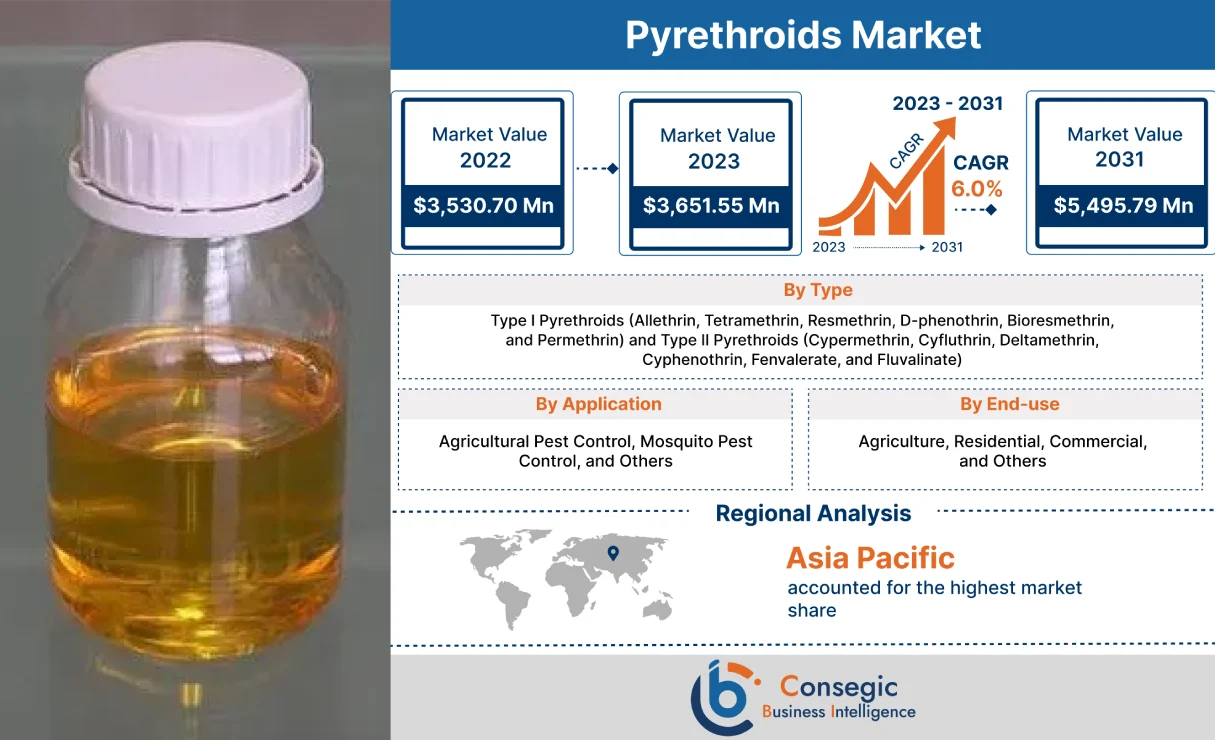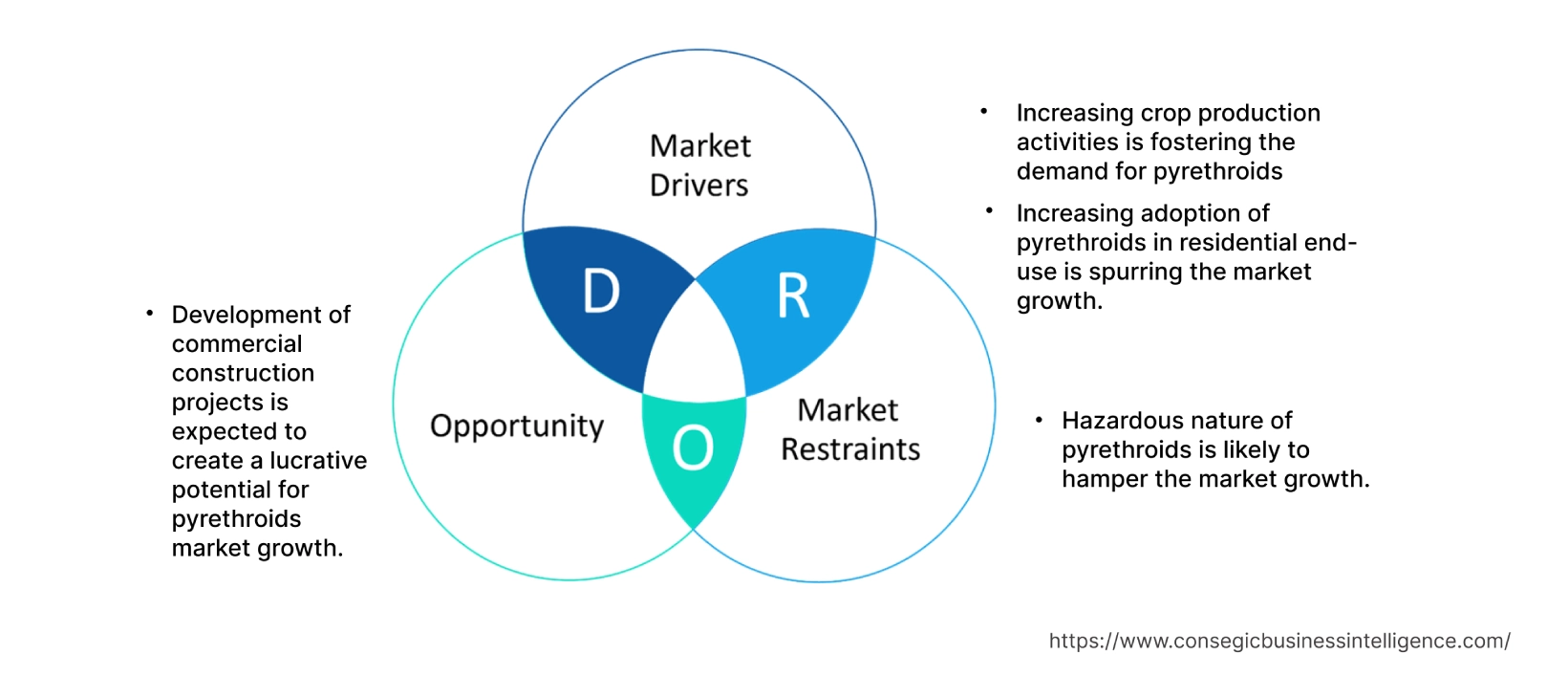- Summary
- Table Of Content
- Methodology
Pyrethroids Market Size :
Consegic Business Intelligence analyzes that the pyrethroids market size is growing with a CAGR of 6.0% during the forecast period (2023-2031), and the market is projected to be valued at USD 5,495.79 Million by 2031 and USD 3,651.55 Million in 2023 from USD 3,530.70 Million in 2022.
Pyrethroids Market Scope & Overview:
Pyrethroids are synthetic chemicals formed on naturally occurring pyrethrins, which occur in chrysanthemums. They are a highly functional solution that is primarily utilized in various pesticide products for the control of a diverse range of pests, including ants, mosquitoes, cockroaches, spiders, agricultural pests, and termites.
Furthermore, the key benefits include long-lasting, residual control, also approved for food processing areas, strong safety profile, and broad-spectrum control, among others. In addition to this, they are also listed by the World Health Organization (WHO) for malaria and dengue control, among others. As a result of the above-mentioned benefits, they are frequently utilized in various end uses, including residential, commercial, agriculture, and others.
Pyrethroids Market Insights :
Key Drivers :
Increasing crop production activities is fostering the demand
Pyrethroid provides a diverse range of benefits to agriculture end users as it controls a broad spectrum of harmful pests such as bollworms, lepidopterous pests, and leafworms, among others. It is highly functional in controlling insects. As a result, they are major utilized for the control of leafworms and bollworms in cotton. Furthermore, it is widely deployed in fruits and vegetables, aphids in cereals, and many other agriculture products for controlling various species of insects, including aphids, lepidopterous, and others.
The technological advancements in the agriculture sector such as automation processes, and the introduction of advanced machinery are accelerating the production of crops. In addition, the increasing self-reliance on the food crop at the global level is further boosting agricultural output. Thus, the market analysis shows that the increasing crop activities are fostering the need for chemicals to ensure efficient crop protection from pests. Hence, the aforementioned factors are contributing to the pyrethroids market growth.
Increasing adoption in residential end-use is spurring the market.
The crucial technical properties associated with the pyrethroid include low volatility, the highly nonpolar nature of low water solubility, and excellent octanol-water partition coefficients, among others. These properties enable efficient insect controls in the residential industry. They are the ideal solution for the residential industry to control insects such as fleas, mosquitoes, moths, flies, ants, and many other insects. They are utilized in various residential applications, including residential houses, residential buildings, and others.
Factors such as reduction in interest rates in countries such as Canada, increasing investments in residential building projects, government initiatives for affordable housing schemes, rising needs for larger living spaces, and other factors are proliferating the residential industry development at the global level. Thus, the market trends analysis shows that this, in turn, has augmented the demand for pyrethroid to enable efficient pest control, thereby spurring the pyrethroids market growth.
Key Restraints :
Hazardous nature is likely to hamper the pyrethroids market.
Pyrethroids are equipped with various beneficial properties, including low water solubility, low vapor pressure, and superior hydrolysis and photolysis stability because of these qualities, they are an advantageous insecticide for the use of mosquito netting, ants, and others. As a result, they are frequently utilized in various industries, including residential, commercial, agriculture, and others, which is boosting the market at the global level. On the contrary, they are considered mildly toxic to living beings. Moreover, longer-term acute exposure to them in living beings leads to skin irritation, eye irritation, and other types of respiratory disorders. Thus, as per the market trends analysis, the hazardous nature of pyrethroid is creating a bottleneck for the pyrethroids market demand.
Future Opportunities :
Development of commercial construction projects is expected to create a lucrative potential for the pyrethroids market opportunities.
Pyrethroid is utilized in the commercial industry for the efficient control of insect pests. The pesticide is deployed in various commercial construction projects, including healthcare infrastructure, office buildings, leisure construction projects, and others as these commercial spaces require superior standards of sanitization and pest control. This prime determinant is boosting the global pyrethroid market.
The increasing investment in the healthcare infrastructure, development of new office buildings, expansion of leisure construction projects, and others are accelerating the development of new commercial construction projects at the global level. Therefore, as per the market trends analysis, the development of new commercial construction projects, and efficient pest control, are a few of the prominent factors that will surge the pyrethroids market opportunities during the projected forecast period.
Global Pyrethroids Market Report Insights :
| Report Attributes | Report Details |
| Study Timeline | 2017-2031 |
| Market Size in 2031 | USD 5,495.79 Million |
| CAGR (2023-2031) | 6.0% |
| By Type | Type I Pyrethroids (Allethrin, Tetramethrin, Resmethrin, D-phenothrin, Bioresmethrin, and Permethrin) and Type II Pyrethroids (Cypermethrin, Cyfluthrin, Deltamethrin, Cyphenothrin, Fenvalerate, and Fluvalinate) |
| By Application | Agricultural Pest Control, Mosquito Pest Control, and Others |
| By End-use | Agriculture, Residential, Commercial, and Others |
| By Region | North America, Europe, Asia-Pacific, Latin America, and Middle East & Africa |
| Key Players | Bayer AG, BASF SE, Sumitomo Chemical Co., Ltd., Heranba Industries Ltd., Aimco Pesticides LTD., Rallis India Limited, Tagros Chemicals India Pvt Ltd, Gharda Chemicals Ltd, Bharat Group, FMC Corporation, Meghmani Organics Ltd, and Hemani Industries Limited |
| Geographies Covered | |
| North America | U.S. Canada Mexico |
| Europe | U.K. Germany France Spain Italy Russia Benelux Rest of Europe |
| APAC | China South Korea Japan India Australia ASEAN Rest of Asia-Pacific |
| Middle East and Africa | GCC Turkey South Africa Rest of MEA |
| LATAM | Brazil Argentina Chile Rest of LATAM |
| Report Coverage | Revenue Forecast, Competitive Landscape, Growth Factors, Restraint or Challenges, Opportunities, Environment & Regulatory Landscape, PESTLE Analysis, PORTER Analysis, Key Technology Landscape, Value Chain Analysis, Cost Analysis, and Regional Trends & Forecast |
Pyrethroids Market Segmental Analysis :
By Type :
On the basis of type, the market is segmented into type I pyrethroids and type II pyrethroids. In 2022, the type II pyrethroids segment accounted for the highest market revenue in the pyrethroids market. They are further classified into cypermethrin, cyfluthrin, deltamethrin, cyphenothrin, fenvalerate, and fluvalinate. These are a class of synthetic insecticides that are known for their slower knockdown and longer residual activity. They are used by farmers to control a variety of insect pests on crops, such as soybeans, corn, and cotton. Also, these are used to control insect pests in livestock facilities. Therefore, as per the analysis of segmental trends, the increasing livestock farming practices are fueling the pyrethroids market demand.
However, the type I pyrethroids segment is expected to grow at the fastest CAGR in the pyrethroids market. They are further classified into allethrin, tetramethrin, resmethrin, d-phenothrin, bioresmethrin, and permethrin. These are a class of synthetic insecticides that are known for their rapid knockdown and short residual activity. This is attributed to increased resistance to other insecticides. Additionally, they are used by public health agencies to control mosquitoes and other insects that transmit diseases, such as malaria and dengue fever. Thus, as per the analysis of segment trends, the increasing initiatives towards malaria control and elimination are one of the prominent factors that are anticipated to surge the pyrethroids market trends over the forecast period. For instance, the WHO global technical strategy for malaria 2016–2030 focuses on reducing malaria case incidence and mortality rates by at least 90% by 2030.
By Application :
On the basis of application, the market is categorized into agricultural pest control, mosquito pest control, and others. In 2022, the agricultural pest control segment accounted for the highest market share at 69.13% of the total pyrethroids market share and is also expected to grow at the fastest CAGR of 5.5% in the pyrethroids market. Process innovations and increasing production of cash crops and food crops are some of the key factors boosting the demand. For instance, according to the report published by the Food and Agriculture Organization of the United Nations, the world production of primary crops increased by 52% between 2000 to 2020. Furthermore, the segmental trends analysis depicts that the rise in research and development activities for new pyrethroid formulations that are more environmentally friendly is another prominent that will aid in surging the product demand over the forecast period.
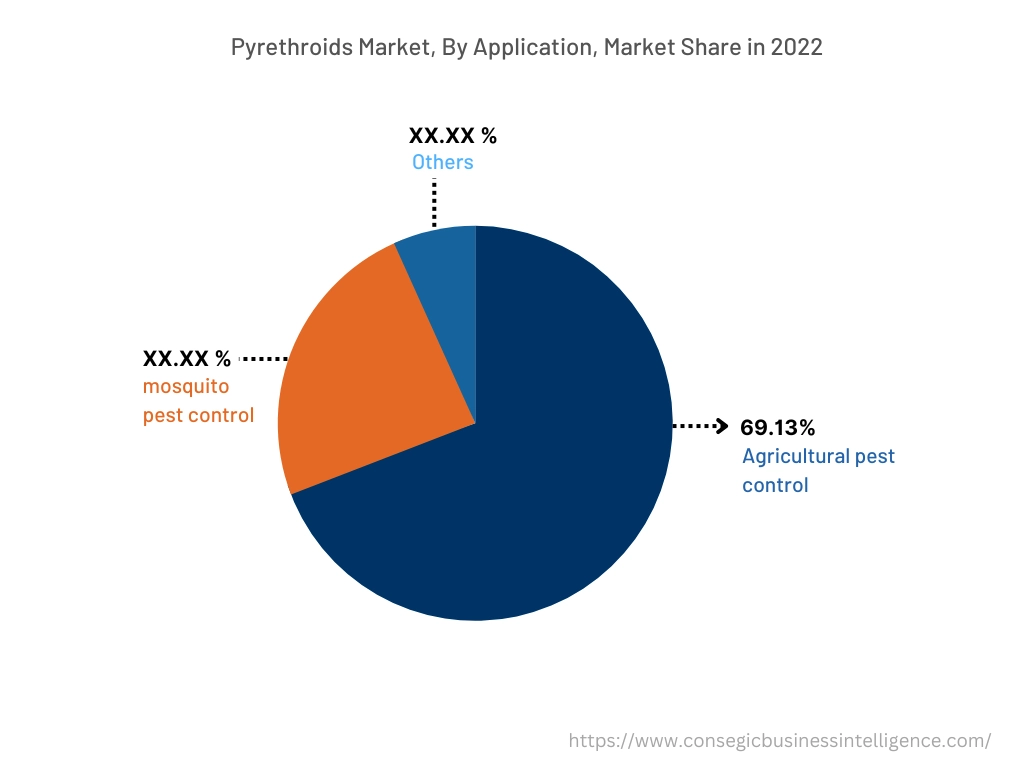
By End-Use :
Based on end-use, the market is categorized into agriculture, residential, commercial, and others. In 2022, the agriculture segment accounted for the highest market share of the overall pyrethroids market share and is also expected to grow at the fastest CAGR in the pyrethroids market. The growth in the agriculture sector at the global level is attributed to factors such as increasing corporate farming, and the growing use of pesticides to increase farm output, among others. Hence, the growth in the use of this chemical to control pests is boosting the agricultural output. For instance, according to the recent statistics published by the United States Department of Agriculture (USDA), in 2022, global oilseed production amounted to 627.4 million metric tons from 610.5 million metric tons in 2021. Hence, in 2022, the year-on-year growth rate of global oilseed production was 2.77% more as compared to the previous year. Therefore, the segmental trends analysis shows that the increase in crop production is expected to fuel pyrethroids market trends in the following years.
By Region :
The regional segment includes North America, Europe, Asia Pacific, the Middle East and Africa, and Latin America.
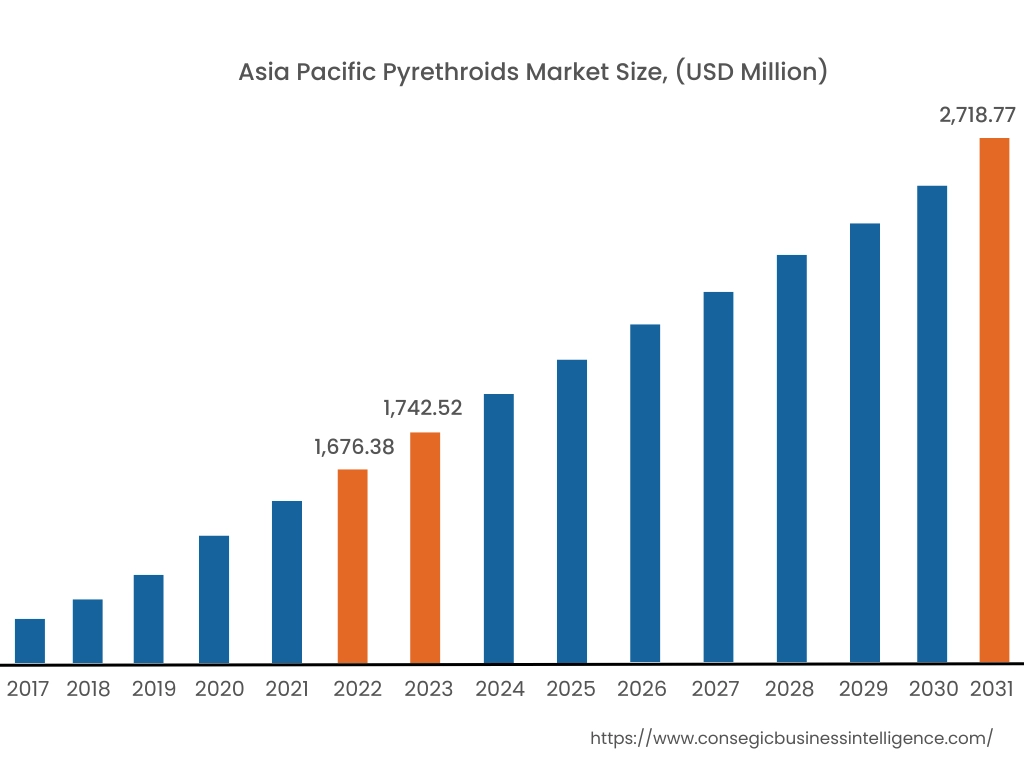
In 2022, Asia Pacific accounted for the highest market share of 47.48% and was valued at USD 1,676.38 million in 2022 and is expected to reach USD 1,742.52 million in 2023 and USD 2,718.77 million in 2031. The region is also expected to grow at the fastest CAGR of 6.6% during the forecast period. As per the pyrethroids market analysis, In the Asia Pacific region, China accounted for the highest market share of 36.86% during the base year 2022. The market growth is attributed to factors such as rising agricultural activities, the development of new pyrethroid formulations, and increasing demand for sustainable pest control solutions. For instance, according to the report published by the United States Department of Agriculture (USDA), in 2022, rice production in India amounted to 136.0 million metric tons from 129.5 million metric tons in 2021. Hence, in 2022, the year-on-year growth rate of global oilseed production was 5.02% more as compared to the previous year. Therefore, the regional analysis shows that the increasing rice production in India is fueling the need for this chemical to control pests including tadpole shrimp, in turn proliferating the pyrethroids market expansion in the region.
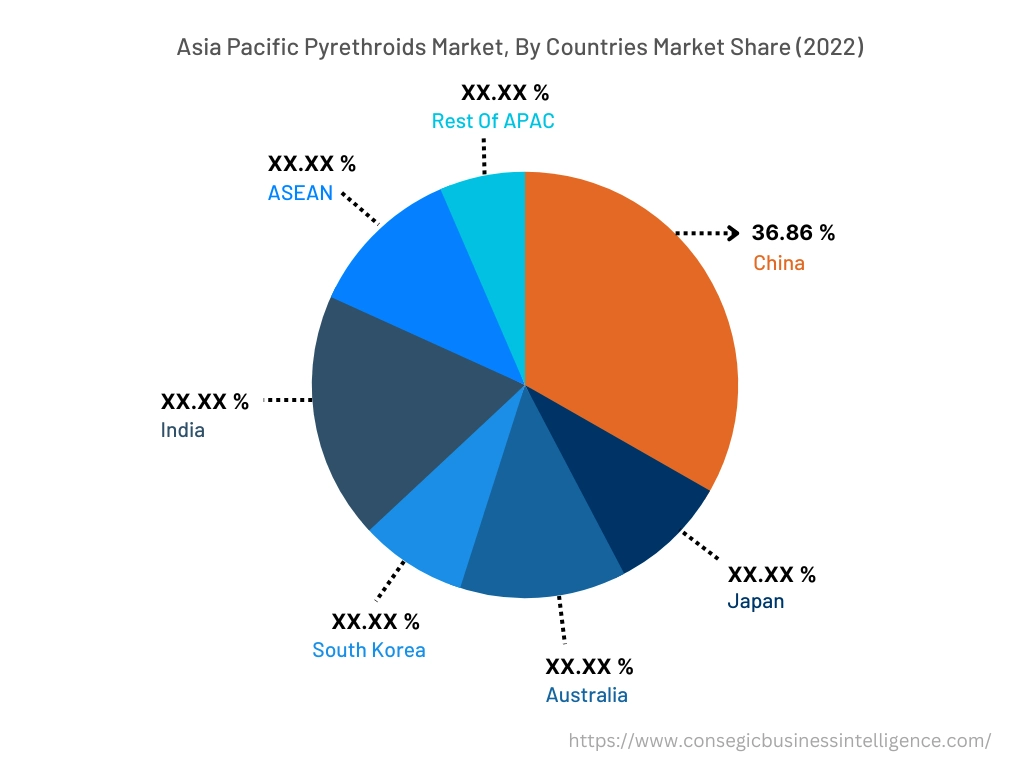
Top Key Players & Market Share Insights:
The pyrethroids market is highly competitive, with several large players and numerous small and medium-sized enterprises. These companies have strong research and development capabilities and a strong presence in the market through their extensive product portfolios and distribution networks. The market is characterized by intense competition, with companies focusing on expanding their product offerings and increasing their market share through mergers, acquisitions, and partnerships. The key players in the pyrethroids industry include-
- Heranba Industries Ltd
- Sumitomo Chemical Co., Ltd.
- Aimco Pesticides LTD.
- Rallis India Limited
- Tagros Chemicals India Pvt Ltd
- Gharda Chemicals Ltd
Recent Industry Developments :
- In May 2021, BASF introduced Alucion 35 WG insecticide for the golf course market. The product is formulated with the active ingredients alpha-cypermethrin and dinotefuran and is a pyrethroid-containing insecticide for golf courses.
- In May 2020, FMC Corporation launched Elevest Insect Control for a wide range of crops such as soybeans, sweet corn, cotton, peanuts, and potatoes. New Elevest insect control comprises Rynaxypyr, which further constitutes bifenthrin, the leading pyrethroid.
Key Questions Answered in the Report
What was the market size of the pyrethroids market in 2022? +
In 2022, the market size of pyrethroids was USD 3,530.70 million
What will be the potential market valuation for the pyrethroids market by 2031? +
In 2031, the market size of pyrethroids is expected to reach USD 5,495.79 million.
What are the key factors driving the growth of the pyrethroids market? +
Increasing adoption of pyrethroids in residential end-use to maintain higher standards of health hygiene is accelerating the market growth.
What is the dominating segment in the pyrethroids market by application? +
In 2022, the agricultural pest control segment accounted for the highest market share in the overall pyrethroids market.
Based on current market trends and future predictions, which geographical region will have the fastest impact on the pyrethroids market's growth in the coming years? +
Asia Pacific is expected to be the fastest-growing region in the market during the forecast period.
